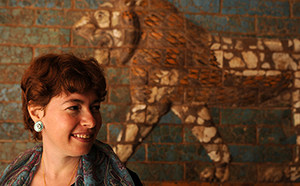Before Saddam
During the mid-20th century, Iraq blossomed briefly as a pluralist society with democratic freedoms.
By Laura Putre
Photography by Dan Dry
Ten years ago Orit Bashkin’s colleagues at Princeton, where she earned a PhD in 2004, were mystified by her dissertation topic, an examination of Iraq as a mid-20th century cultural force. “Everybody was like, ‘Iraq? No, really, the intellectual centers are in Egypt, in Lebanon,’” recalls Bashkin, associate professor of modern Middle Eastern history. “‘Why don’t you write something about that?’”
But by 2003, when the United States invaded Iraq under the banner of democracy, Bashkin’s look back at a freer Iraq had become quite topical. Her study of the country’s cultural flowering from 1921 to 1958—its years as a monarchy with some democratic freedoms—developed into a book, The Other Iraq: Pluralism and Culture in Hashemite Iraq (Stanford University Press), set for release in December.
 “The idea that Iraq is merely an artificial state” imposed from without, Orit Bashkin asserts, “is quite problematic.”
“The idea that Iraq is merely an artificial state” imposed from without, Orit Bashkin asserts, “is quite problematic.” Through close readings of Iraqi literature and intellectual journals from the period, Bashkin sets out to dispel the common misconception that Iraqis were never interested in democracy—that outsiders had to impose democracy for the Iraqi people to realize its virtues. “Iraqis write about democracy and the virtues of democracy from the 1920s until 1958,” says Bashkin. “It’s true that during the history of Iraq, there are fascist voices, there are ultranationalist and militaristic voices, but there has always been an opposition group that supported democracy. I thought it was important to document those voices.”
Those voices include neoclassical poet Ma’ruf al-Rusafi, who presided over the Haydarkhana coffeehouse; Abd al-Wahhab al-Bayati, a modernist poet exiled from Iraq in the 1950s for his leftist politics; and fiction writer Abd al-Malik Nuri, who broke with tradition by writing in the voice of the common man rather than in Fusha, the Arabic literary language.
Bashkin’s book covers the period after World War I, when the Ottoman Empire crumbled, and the British were given a mandate to rule the new country formed from the regions of Baghdad, Basra, and later Mosra. Rather than colonize Iraq, the British chose King Faisal, deposed leader of Syria and a member of the Arab royal Hashemite family, to rule the country. The family remained in power under Britain’s watchful eye until a 1958 military coup paved the way to dictatorship in 1968, when leaders of the Ba’th party imposed authoritarian rule.
Although the Iraqi state was thrust upon them, people in the region tended to identify not only with their particular ethnicity, but also as Iraqi, in part because they shared the Arabic language and political ties dating back 400 years. “You find writing in the vernacular, in the Iraqi dialect, during that time in which people identify themselves as Iraqi patriots. ”
The constitutional monarchy fostered openness, to a degree. Men, but not women, could vote in local elections, and education abroad was encouraged. Citizens—at first only men, but by the 1930s women too—could gather publicly and talk openly about freeing the Arab state from the remnants of British sovereignty.
Journals of the day featured experimental poetry, discussions of existentialism, and articles on modernist architecture and Mexican muralists. Children read Arabic translations of Tarzan, embarking on a path to lifelong readership. As literacy increased with more middle-class educational opportunities, schools became important gathering places. University and high-school students initiated two major grassroots demonstrations against British intervention in Iraqi democracy: al-Wathbah in 1948 and Intifada in 1952.
Bashkin, who holds an Israeli passport, has never actually set foot in Iraq. Israel considers Iraq an enemy nation and prohibits its citizens from traveling there without special permission from the Ministry of the Interior. Yet most of the texts Bashkin studied, obscure to American scholars, were relatively easy to track down in U.S. university libraries. She also conducted interviews with Iraqi colleagues familiar with the Hashemite period—and noticed that her subjects grew more somber after the United States invaded in 2003. “A lot of people I was in contact with were telling me, ‘My sister is not doing well; my family’s not doing well,’” Bashkin says. Research “became a sad personal experience.”
She tried to keep the focus on that 1921–1958 period, which had been overshadowed by repression and atrocities during Saddam Hussein’s regime. “Iraq has not always been the ‘Republic of Fear,’” she says. “We should not project what we are seeing today onto the Iraqi scene of the 1950s. I want to point out a little bit of our arrogance by showing that there [was] a vibrant culture here, that Iraqis themselves want democracy. They fought for a democracy and paid a heavy price.”
Even Iraqi Shiites and Jews, who faced widespread discrimination during the Hashemite era, felt a sense of ownership and responsibility toward their country, Bashkin contends. “There was the realization that,” in a democracy, “you can try and make the state a better place for you.”
She calls her book an exploration of not just what separates Iraqis-—“we know that”—but also what keeps them together. “It will not help us understand Saddam Hussein or why he executed so many people,” she says, “but it will tell us what it meant to be a modern, middle-class person in Baghdad—and that’s also important.”
Return to top